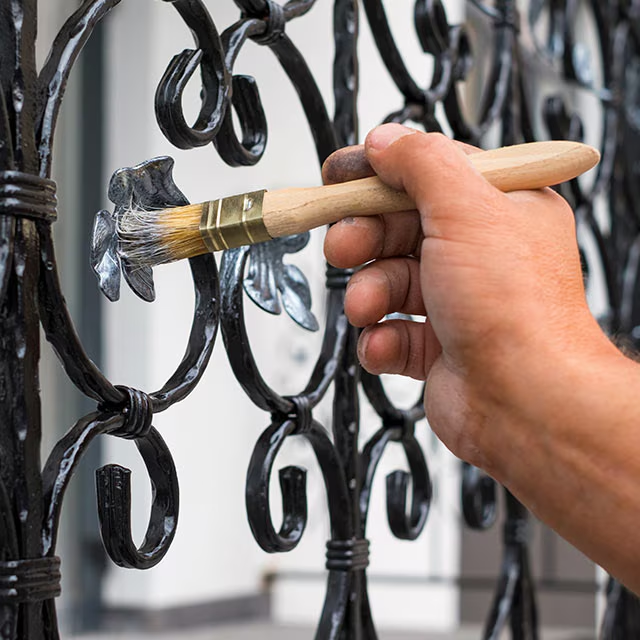What Kind of Paint Can You Use on Metal?
Undertaking a metal painting project requires careful consideration beyond just color selection. Choosing the right paint is paramount for achieving a long-lasting, aesthetically pleasing finish that protects the underlying metal from corrosion and wear. This article delves into the world of metal paints, equipping you with the knowledge to make informed decisions for your next project.
Understanding Metal Paints
Metal paints are specially formulated to adhere tenaciously to metal surfaces and withstand the rigors of exposure to the elements. Unlike their standard counterparts, metal paints possess superior anti-corrosion properties, often incorporating rust-inhibiting pigments that shield the metal from oxidation. These pigments, such as zinc phosphate or red lead (though the latter is less common due to environmental concerns), act as a bulwark against the insidious creep of rust, safeguarding the structural integrity of the metal for years to come. Furthermore, metal paints boast of excellent flexibility, accommodating the natural expansion and contraction of metal surfaces due to temperature fluctuations. This resilience prevents the paint from cracking or peeling, ensuring a pristine aesthetic and continued protection.
Metal paints come in two primary formulations: oil-based and water-based. Oil-based metal paints offer unparalleled durability and a smooth, high-gloss finish. Their enamel-like quality creates a hard, impervious shell that can withstand harsh weather conditions and even mild abrasion. However, their strong solvent content necessitates meticulous cleanup procedures with mineral spirits or paint thinners. These solvents can be hazardous if not handled properly, requiring appropriate ventilation and personal protective equipment. Additionally, oil-based paints contribute to Volatile Organic Compound (VOC) emissions, which can have a negative impact on indoor air quality and the environment.
Conversely, water-based metal paints are low in odor, easier to clean up with soap and water, and boast faster drying times. This makes them a more user-friendly option, particularly for indoor projects or applications where quick turnaround times are essential. While they may not achieve the same level of sheen as oil-based paints, advancements in technology have yielded water-based options with acrylic or alkyd resins that provide exceptional performance and durability. These advancements have blurred the lines between the two categories, offering water-based paints that can rival the resilience of their oil-based counterparts.
Choosing the Right Paint for the Metal Type
Not all metals are created equal, and the type of metal you’re working with will significantly impact your paint selection. Metals are broadly categorized into two groups: ferrous and non-ferrous. Ferrous metals, like steel and iron, are magnetic and highly susceptible to rust. Non-ferrous metals, such as aluminum, copper, and brass, are generally resistant to rust but may develop a patina over time.
When painting ferrous metals, prioritizing rust prevention is paramount. Opt for a paint specifically formulated for ferrous metals, as these paints often contain additional rust-inhibiting pigments and a higher level of adhesion to ferrous surfaces. Oil-based paints have traditionally been the go-to choice for ferrous metals due to their superior durability. However, advancements in water-based technology have made them a viable alternative, particularly for those seeking a more user-friendly and environmentally conscious option.
For non-ferrous metals, the primary concern is ensuring proper adhesion. These metals typically have a smoother, less porous surface compared to ferrous metals. A high-quality primer specifically designed for non-ferrous metals is crucial for creating a strong bond between the paint and the metal substrate. Once the primer is applied, you can choose from a wider range of paint options, including both oil-based and water-based varieties.
Application Considerations
Beyond the paint itself, proper surface preparation and application techniques are vital for a successful metal painting project. The first step is to thoroughly clean the metal surface, removing any dirt, grease, or rust. For heavily rusted surfaces, a wire brush or power sander may be necessary to remove loose rust and create a good texture for the paint to adhere to. Once the surface is clean, apply a coat of high-quality primer specifically formulated for the type of metal you’re working with. The primer acts as a bridge between the metal and the paint, promoting optimal adhesion and enhancing the overall durability of the finish.
After the primer is dry, apply the paint in thin, even coats. It’s generally better to apply multiple thin coats rather than one thick coat, as this allows for better drying and reduces the risk of drips and runs. Always consult the paint manufacturer’s recommendations for drying times and the number of recommended coats.





